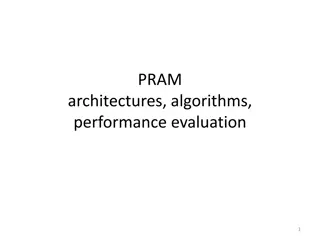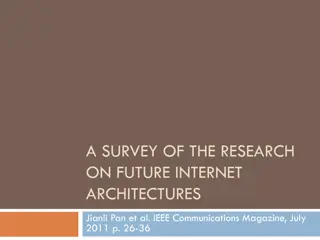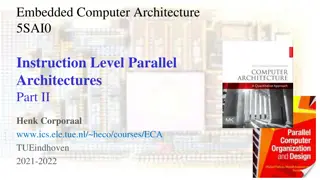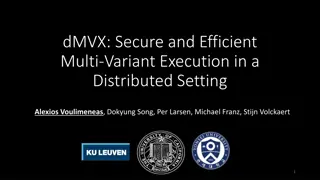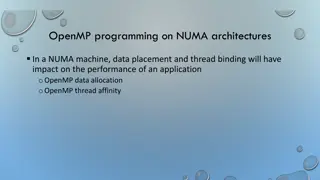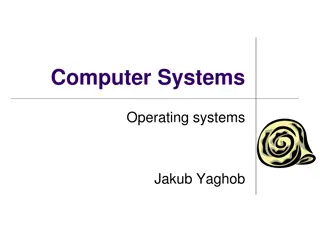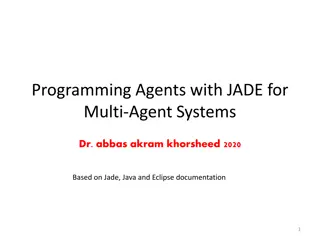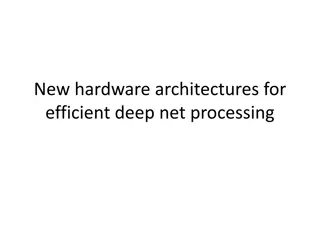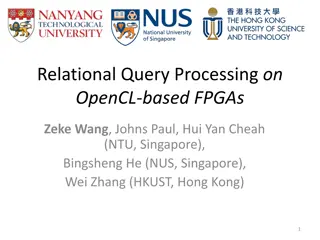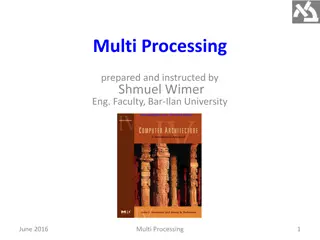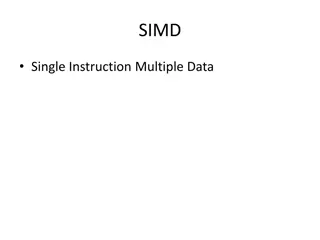Efficient Resource Management for Multi-Agent System Execution on Parallel Architectures with OpenCL
This research focuses on efficiently managing memory and computing resources for executing multi-agent systems on parallel architectures using OpenCL. The study presents a hybrid approach involving population-level molecular virtual chemistry and individual-level virtual cells. The work enhances a previous Ph.D. thesis and aims to improve computational biology and bioinformatics. The implementation involves tissue morphogenesis, virtual biological models, molecular virtual chemistry, and parallel implementation using OpenCL. Results include insights into virtual cell identification and dynamic processes in tissue development.
- Efficient Resource Management
- Multi-Agent Systems
- Parallel Architectures
- OpenCL
- Computational Biology
Download Presentation

Please find below an Image/Link to download the presentation.
The content on the website is provided AS IS for your information and personal use only. It may not be sold, licensed, or shared on other websites without obtaining consent from the author. Download presentation by click this link. If you encounter any issues during the download, it is possible that the publisher has removed the file from their server.
E N D
Presentation Transcript
Gestion efficace des ressources m moire et de calcul pour l ex cution de syst me multi-agents sur architectures parall les avec OpenCL Anne Jeannin-Girardon, Vincent Rodin Lab-STICC, UMR 6285, CNRS, D pt Informatique, Universit de Brest 1 Compas 2016, vincent.rodin@univ-brest.fr
Lab-STICC, CID, IHSEV Virtual Reality Virtual Biology Interaction between virtual cells and/or molecules 2
Context (2/3) Our approach is hybrid population level (Molecular Virtual Chemistry) individual level (Virtual Cells) 4
Context (3/3) From a computational point of view, the work presented today is an improvement of Anne Jeannin-Girardon Ph.D thesis, 2014 Anne Jeannin-Girardon et al, IEEE/ACM Transaction on Computational Biology and Bioinformatics, 2015 5
Outline Introduction Morphogenesis & Dynamicity Virtual Biological Model Virtual Cell, Molecular Virtual Chemistry, Virtual Growth Parallel implementation OpenCL, model coupled with a MAS How to get a new Id for a new Virtual Cell? Results 6
Introduction (1/1) Tissue morphogenesis: Is a multi-scale phenomenon Tissular level processes Macroscopic scale Can be addressed through continuous & discrete models Cell/Cell & cell/ECM interactions Mesoscopic scale Involves many of interacting entities (cells, molecules, etc.) Sub-cellular/ molecular processes Implies birth and death of cells dynamicity Microscopic scale 7
Virtual Biological Model (1/3) Virtual Cell Structure: mass/spring system n+1 nodes membrane, cytoskeleton, cortex cell deformation Mitose orientated mitosis given an axis Cell adhesion/repulsion differential interaction 8
Virtual Biological Model (2/3) Molecular Virtual Chemistry Molecular level modelled with diffusion/reaction equations i(x,t) t =Di i(x,t) Ri(x,t) Set of molecules. Ex: {A, B,C} Set of reactions. Ex: {2A + B C} Set of 2D discrete layers. One grid layer per molecule type Equations solved in 2 steps: 1) diffusion 2) reaction 9
Virtual Biological Model (3/3) Virtual Growth TA B TB produces A C consumes TD D TC Dynamicity 10
Hey Vincent, do you know that you are not in a bioinformatics conference today? 11
Parallel implementation (1/2) Parallel hardware and device are everywhere Parallel programing gets easier Numerous parallel frameworks are available Our model seems well adapted to parallel implementation We choose to use the OpenCL framework to implement it we can use CPUs, GPUs, FPGAs, etc. 12
Parallel implementation (2/2) Fine grained implementation: a cell = an OpenCL core model coupled with a Multi-Agent System Kernel k1: computes forces Kernel k2: integrates forces (Euler method) Data stored into structures of arrays: nodes, etc. adapted data structure for OpenCL: a cell = an id Question: How to find a new Id for a new Virtual Cell? 13
How to get a new Id ? (1/3) N ( 106) Virtual Cells : structures of arrays 0 1 2 N-1 Active or Inactive Node 0 Node 1 Node 5 Node C Etc. At the beginning of the simulation easy! 14
How to get a new Id ? (1/3) N ( 106) Virtual Cells : structures of arrays 0 1 2 N-1 Active or Inactive Node 0 Node 1 Node 5 Node C Etc. After births and deaths .? 15
How to get a new Id ? (2/3) Some previous works (1): [Lysenko & D Souza, 2008] 0 1 2 N-1 Active or Inactive Attributes A stochastic method: A random choise happens until an inactive element is obtained! Main drawback: What appends if the memory is nearly full? 16
How to get a new Id ? (2/3) Some previous works (2): [Jeannin-Girardon, Ph.D, 2014] [Jeannin-Girardon et al, TCBB, 2015] 0 1 2 N-1 Active or Inactive Attributes A hybrid method: Dynamic switch : Stochastic Method & Parallel Sort 17
How to get a new Id ? (2/3) Some previous works (2): [Jeannin-Girardon, Ph.D, 2014] [Jeannin-Girardon et al, TCBB, 2015] 0 1 2 N-1 0 1 2 N-1 Active or Inactive Attributes A hybrid method: Dynamic switch : Stochastic Method & Parallel Sort Main drawbacks: - How to choose the thresholds to switch? - Parallel sort data transfers 18
How to get a new Id ? (3/3) Our proposition (1): [Jeannin-Girardon et al, Compas, 2016] 0 1 2 N-1 Active or Inactive Attributes Available Indexes are stored in two buffers & atomic_inc 0 1 2 N-1 0 1 2 3 N-1 Allocation Deallocatio n PtrDeallocation PtrAllocation -1 -1 -1 -1 -1 -1 -1 -1 -1 -1 -1 -1 -1 19
How to get a new Id ? (3/3) Our proposition (1): [Jeannin-Girardon et al, Compas, 2016] 0 1 2 N-1 Active or Inactive Attributes Available Indexes are stored in two buffers & atomic_inc 0 1 2 N-1 -1 1 2 3 N-1 Allocation Deallocatio n PtrDeallocation PtrAllocation -1 -1 -1 -1 -1 -1 -1 -1 -1 -1 -1 -1 -1 20
How to get a new Id ? (3/3) Our proposition (1): [Jeannin-Girardon et al, Compas, 2016] 0 1 2 N-1 Active or Inactive Attributes Available Indexes are stored in two buffers & atomic_inc 0 1 2 N-1 -1 -1 2 3 N-1 Allocation Deallocatio n PtrDeallocation PtrAllocation -1 -1 -1 -1 -1 -1 -1 -1 -1 -1 -1 -1 -1 21
How to get a new Id ? (3/3) Our proposition (1): [Jeannin-Girardon et al, Compas, 2016] 0 1 2 N-1 Active or Inactive Attributes Available Indexes are stored in two buffers & atomic_inc 0 1 2 N-1 -1 -1 -1 3 N-1 Allocation Deallocatio n PtrDeallocation PtrAllocation -1 -1 -1 -1 -1 -1 -1 -1 -1 -1 -1 -1 -1 22
How to get a new Id ? (3/3) Our proposition (1): [Jeannin-Girardon et al, Compas, 2016] 0 1 2 N-1 Active or Inactive Attributes Available Indexes are stored in two buffers & atomic_inc 0 1 2 N-1 -1 -1 -1 3 N-1 Allocation Deallocatio n PtrDeallocation PtrAllocation 1 -1 -1 -1 -1 -1 -1 -1 -1 -1 -1 -1 -1 23
How to get a new Id ? (3/3) Our proposition (1): [Jeannin-Girardon et al, Compas, 2016] 0 1 2 N-1 Active or Inactive Attributes Available Indexes are stored in two buffers & atomic_inc 0 1 2 N-1 -1 -1 -1 3 N-1 Allocation Deallocatio n PtrDeallocation PtrAllocation 1 -1 -1 -1 -1 -1 -1 -1 -1 -1 -1 -1 -1 24
How to get a new Id ? (3/3) Our proposition (1): [Jeannin-Girardon et al, Compas, 2016] 0 1 2 N-1 Active or Inactive Attributes Available Indexes are stored in two buffers & atomic_inc 0 1 2 N-1 -1 -1 -1 3 N-1 Allocation Deallocatio n PtrDeallocation PtrAllocation 1 2 -1 -1 -1 -1 -1 -1 -1 -1 -1 -1 -1 25
How to get a new Id ? (3/3) Our proposition (1): [Jeannin-Girardon et al, Compas, 2016] 0 1 2 N-1 Active or Inactive Attributes Available Indexes are stored in two buffers & atomic_inc 0 1 2 N-1 -1 -1 -1 3 N-1 Allocation Deallocatio n PtrDeallocation PtrAllocation 1 2 -1 -1 -1 -1 -1 -1 -1 -1 -1 -1 -1 26
How to get a new Id ? (3/3) Our proposition (1): [Jeannin-Girardon et al, Compas, 2016] 0 1 2 N-1 Active or Inactive Attributes Available Indexes are stored in two buffers & atomic_inc 0 1 2 N-1 -1 -1 -1 -1 -1 -1 -1 -1 -1 -1 -1 -1 -1 Allocation Deallocatio n PtrDeallocation PtrAllocation 1 2 -1 -1 -1 -1 -1 -1 -1 -1 -1 -1 -1 27
How to get a new Id ? (3/3) Our proposition (1): [Jeannin-Girardon et al, Compas, 2016] 0 1 2 N-1 Active or Inactive Attributes Available Indexes are stored in two buffers & atomic_inc 0 1 2 N-1 1 2 -1 -1 -1 -1 -1 -1 -1 -1 -1 -1 -1 Allocation Deallocatio n PtrDeallocation PtrAllocation -1 -1 -1 -1 -1 -1 -1 -1 -1 -1 -1 -1 -1 28
How to get a new Id ? (3/3) Our proposition (2): [Jeannin-Girardon et al, Compas, 2016] res = atomic_inc(var): OpenCL atomic operation tmp=var; var++; return tmp Deallocation: Allocation: Ptr = atomic_inc(PtrDeallocation) Desallocation[Ptr] = Id Ptr = atomic_inc(PtrAllocation) If Ptr < N and Allocation[Ptr] != -1 Then Id = Allocation[Ptr] Allocation[Ptr] = -1 Return Id Endif PtrAllocation 0 1 2 N-1 1 2 -1 -1 -1 -1 -1 -1 -1 -1 -1 -1 -1 Allocation Deallocatio n -1 -1 -1 -1 -1 -1 -1 -1 -1 -1 -1 -1 -1 PtrDeallocation 29
How to get a new Id ? (3/3) Our proposition (3): [Jeannin-Girardon et al, Compas, 2016] Swap conditions: PtrAllocation 0 1 2 N-1 -1 -1 -1 -1 -1 -1 -1 -1 -1 -1 -1 -1 -1 Allocation Deallocatio n 1 2 -1 -1 -1 -1 -1 -1 -1 -1 -1 -1 -1 PtrAllocation 0 1 2 N-1 -1 -1 -1 -1 -1 -1 -1 -1 -1 -1 -1 -1 -1 3 5 4 -1 -1 -1 -1 -1 -1 -1 -1 -1 -1 Allocation Deallocatio n 30
Results: Prey-Predator model (1/2) Prey-Predator model High dynamicity 31
Results: Prey-Predator model (2/2) Hybrid method Double buffer method 32
Questions ? 33










